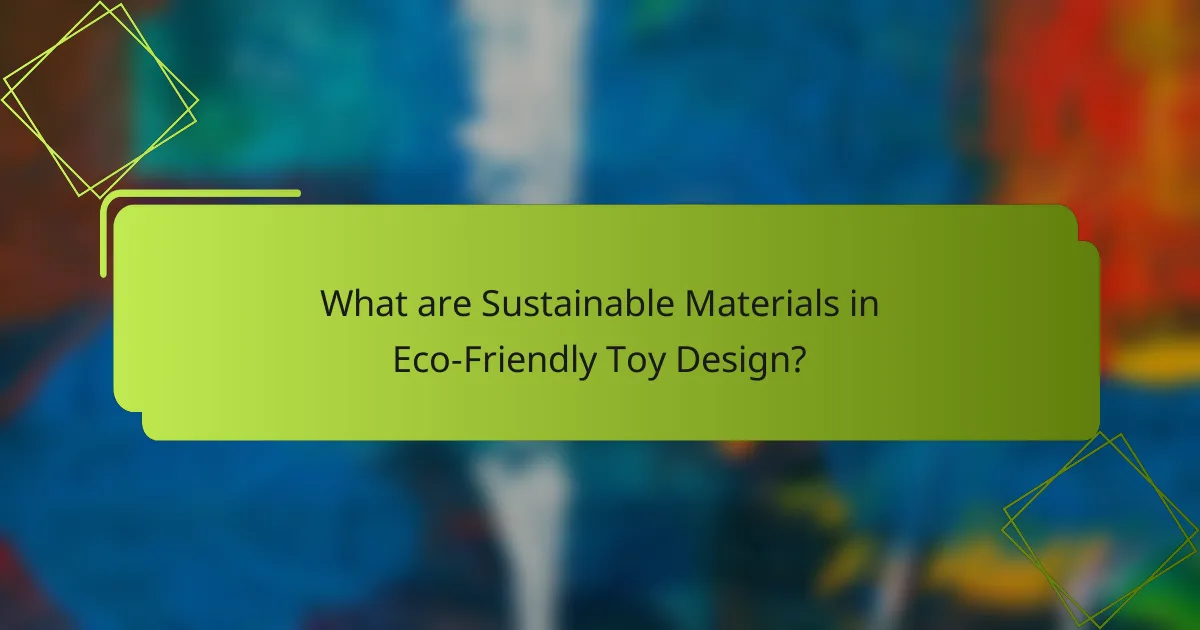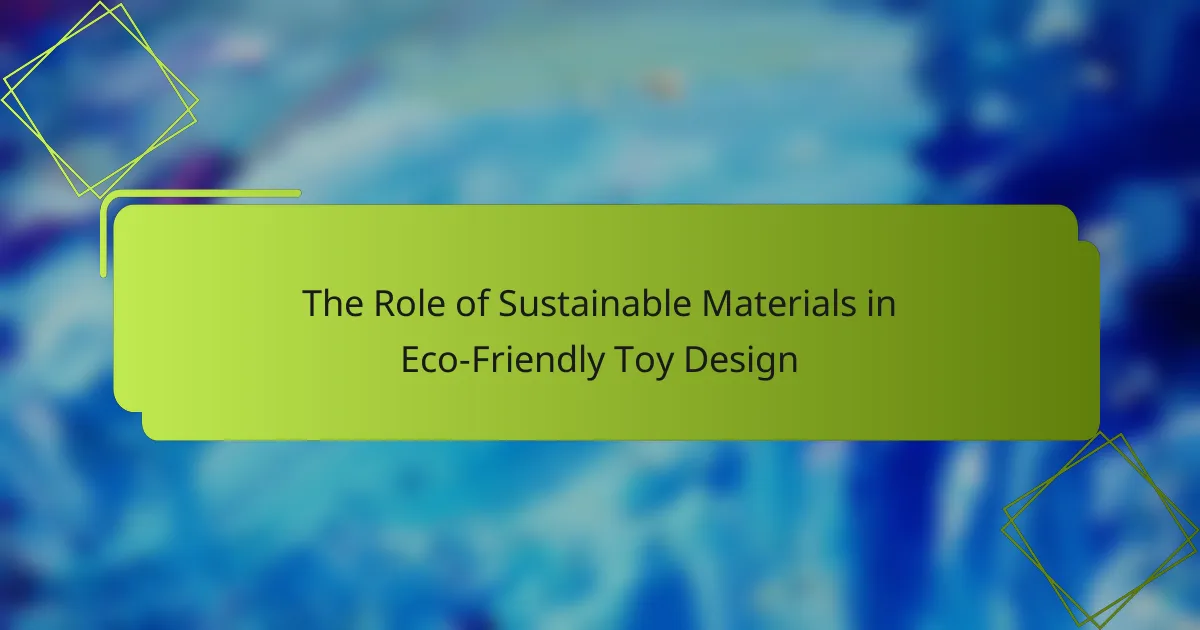
What are Sustainable Materials in Eco-Friendly Toy Design?
Sustainable materials in eco-friendly toy design are resources that minimize environmental impact. These materials are often renewable, biodegradable, or recyclable. Common examples include bamboo, organic cotton, and recycled plastics. Using sustainable materials reduces waste and conserves natural resources. Research indicates that toys made from these materials can be just as durable and safe as traditional options. A study published by the Journal of Cleaner Production highlights the benefits of using bio-based materials in toy manufacturing. This approach supports a circular economy and promotes responsible consumption. Sustainable materials ultimately contribute to a healthier planet for future generations.
Why are sustainable materials important in toy manufacturing?
Sustainable materials are important in toy manufacturing because they reduce environmental impact. Using renewable resources minimizes depletion of non-renewable materials. Sustainable materials often have lower carbon footprints compared to conventional options. They can also be biodegradable or recyclable, reducing waste in landfills. According to a study by the Ellen MacArthur Foundation, transitioning to sustainable materials can cut plastic pollution significantly. Furthermore, consumers increasingly prefer eco-friendly products, driving demand for toys made from sustainable sources. This shift can enhance brand reputation and customer loyalty in the toy market.
What are the environmental impacts of traditional toy materials?
Traditional toy materials often have significant environmental impacts. Common materials like plastic contribute to pollution and landfill waste. Plastics can take hundreds of years to decompose. This results in long-lasting environmental damage. Additionally, the production of plastic toys releases harmful chemicals. These chemicals can contaminate air and water sources. Wood toys, while more sustainable, can lead to deforestation if not sourced responsibly. The extraction of raw materials for both types can disrupt ecosystems. Overall, traditional toy materials often harm the environment through pollution, waste, and resource depletion.
How do sustainable materials contribute to reducing waste?
Sustainable materials contribute to reducing waste by minimizing resource consumption and promoting recyclability. These materials often come from renewable sources, such as bamboo or recycled plastics. Using renewable resources decreases the demand for virgin materials, which often leads to waste generation during extraction and processing. Additionally, sustainable materials are designed for durability, extending the life of products and reducing the frequency of disposal. Many sustainable materials are also biodegradable, breaking down naturally without harming the environment. Research shows that using biodegradable materials can significantly reduce landfill waste. For example, a study published in the Journal of Cleaner Production found that biodegradable plastics can reduce plastic waste by up to 50% in certain applications. By adopting sustainable materials, manufacturers can effectively decrease overall waste production in the toy industry.
What types of sustainable materials are commonly used in eco-friendly toys?
Eco-friendly toys commonly use sustainable materials such as wood, bamboo, organic cotton, and recycled plastics. Wood is often sourced from responsibly managed forests, ensuring minimal environmental impact. Bamboo is a fast-growing plant that requires less water and no pesticides, making it a highly sustainable option. Organic cotton is grown without harmful chemicals, promoting soil health and reducing pollution. Recycled plastics help divert waste from landfills and reduce the need for new plastic production. These materials not only minimize environmental harm but also contribute to the safety and durability of toys.
What are the benefits of using bamboo in toy design?
Bamboo in toy design offers numerous benefits. It is a sustainable material that grows rapidly, making it an eco-friendly choice. Bamboo is biodegradable, reducing environmental impact compared to plastic toys. Its natural antibacterial properties enhance safety for children. The material is lightweight yet durable, ensuring longevity in toys. Bamboo can be easily molded into various shapes, allowing for creative designs. Additionally, it has a unique aesthetic appeal, attracting consumers seeking natural products. Studies indicate that bamboo toys can be safer for children, reducing exposure to harmful chemicals found in synthetic materials.
How does recycled plastic play a role in sustainable toy production?
Recycled plastic significantly contributes to sustainable toy production by reducing waste and conserving resources. This material is derived from post-consumer plastic waste, preventing it from ending up in landfills. Utilizing recycled plastic decreases the need for virgin plastic, which requires fossil fuels and energy for production. In fact, using recycled plastics can save up to 66% of the energy needed compared to producing new plastic. Additionally, toys made from recycled plastic can be designed to be durable and safe for children. Many manufacturers are now adopting this practice to meet eco-friendly standards and consumer demand for sustainable products. This shift not only benefits the environment but also promotes a circular economy in the toy industry.
What certifications exist for sustainable materials in toys?
Certifications for sustainable materials in toys include several recognized standards. The Forest Stewardship Council (FSC) certifies wood products from responsibly managed forests. The Global Organic Textile Standard (GOTS) certifies organic textiles used in toys. The Cradle to Cradle Certified™ program assesses products for safety and sustainability throughout their lifecycle. The ASTM F963 standard ensures toy safety and can include considerations for sustainable materials. These certifications help consumers identify toys made from environmentally friendly materials.
What does the Forest Stewardship Council (FSC) certification signify?
The Forest Stewardship Council (FSC) certification signifies that a product is sourced from responsibly managed forests. This certification ensures that the forest management practices meet strict environmental, social, and economic standards. FSC-certified products support the protection of biodiversity and the rights of indigenous peoples. They also promote sustainable forestry practices that prevent deforestation and degradation. The FSC label helps consumers identify products that contribute to sustainable forest management. This certification is recognized globally and is a key component in promoting eco-friendly materials, particularly in industries like toy design.
How does the Global Organic Textile Standard (GOTS) apply to toy materials?
The Global Organic Textile Standard (GOTS) applies to toy materials by ensuring they meet specific organic and environmental criteria. GOTS certification requires that at least 70% of the textile in toys is made from organic fibers. These fibers must be produced without harmful chemicals or synthetic fertilizers. Additionally, GOTS mandates that the entire production process adheres to strict environmental and social criteria. This includes responsible water usage and fair labor practices. GOTS also prohibits the use of toxic dyes and finishes in toy production. Compliance with GOTS helps guarantee that toys are safe for children and environmentally friendly. Thus, GOTS plays a crucial role in promoting sustainable practices in the toy industry.

How do Sustainable Materials Affect Toy Design and Safety?
Sustainable materials significantly influence toy design and safety. These materials are often non-toxic and biodegradable. They reduce the risk of harmful chemical exposure to children. For instance, wood and organic cotton are safer alternatives to plastic. Sustainable materials also promote durability, leading to longer-lasting toys. This reduces waste and encourages responsible consumption. Research indicates that toys made from sustainable materials can meet safety standards effectively. The American Society for Testing and Materials (ASTM) has guidelines that many sustainable toys adhere to. Therefore, using sustainable materials enhances both the safety and environmental impact of toys.
What design considerations are influenced by the use of sustainable materials?
Sustainable materials influence several design considerations in eco-friendly toy design. First, they affect the choice of materials used, prioritizing those that are renewable or recyclable. This leads to a reduced environmental impact during production. Second, the durability of sustainable materials impacts the design lifespan of toys. Longer-lasting materials result in fewer replacements, promoting sustainability. Third, safety standards are influenced by the non-toxic nature of sustainable materials. Compliance with these standards is crucial for children’s products. Fourth, aesthetic considerations may change, as sustainable materials often have unique textures and finishes. This can enhance the toy’s visual appeal. Lastly, the sourcing of sustainable materials can affect the supply chain logistics. Designers must consider local sourcing to minimize carbon footprints.
How do sustainable materials impact the durability of toys?
Sustainable materials enhance the durability of toys by providing stronger and more resilient properties. These materials often include natural fibers, recycled plastics, and biodegradable substances. For instance, bamboo and organic cotton are known for their strength and longevity compared to conventional materials. Research shows that toys made from sustainable materials can withstand wear and tear better over time. Additionally, sustainable materials are often free from harmful chemicals, reducing the risk of degradation. This leads to a longer lifespan for the toys, making them more cost-effective in the long run. Thus, using sustainable materials directly contributes to improved durability in toy design.
What safety standards must eco-friendly toys meet?
Eco-friendly toys must meet several safety standards to ensure they are safe for children. These standards include ASTM F963, which covers toy safety in the United States. They also need to comply with EN71, the European standard for toy safety. Additionally, eco-friendly toys should be free from harmful chemicals, such as phthalates and lead. The toys must undergo testing for mechanical and physical properties to prevent hazards like choking. Certification from recognized organizations, such as CPSIA, is often required. These regulations aim to protect children from potential risks associated with toy use. Compliance with these standards demonstrates a commitment to safety in eco-friendly toy design.
What challenges do manufacturers face when using sustainable materials?
Manufacturers face several challenges when using sustainable materials. One significant challenge is the higher cost of sustainable materials compared to conventional options. This can impact production budgets and pricing strategies. Another challenge is the limited availability of sustainable materials in the market. This can lead to supply chain disruptions and delays.
Manufacturers also encounter performance issues with some sustainable materials. These materials may not always meet the same durability or functionality standards as traditional materials. Additionally, there may be regulatory hurdles related to the sourcing and certification of sustainable materials. Compliance with these regulations can complicate the manufacturing process.
Finally, there is often a lack of consumer awareness regarding sustainable materials. This can result in lower demand for eco-friendly products, making it difficult for manufacturers to justify the transition. Overall, these challenges can hinder the widespread adoption of sustainable materials in manufacturing.
How does the cost of sustainable materials compare to traditional options?
Sustainable materials often have higher initial costs compared to traditional options. For example, bamboo and organic cotton can be 10-30% more expensive than conventional plastics. This price difference arises from factors such as sourcing, production methods, and lower economies of scale. However, sustainable materials can lead to long-term savings through durability and reduced environmental impact. Research shows that consumers are increasingly willing to pay a premium for eco-friendly products, indicating a shift in market demand. Ultimately, while the upfront costs are higher, the overall value and benefits may justify the investment.
What supply chain issues can arise with sustainable material sourcing?
Supply chain issues that can arise with sustainable material sourcing include limited availability of materials. Sustainable materials often have a smaller supply base compared to conventional options. This can lead to increased costs due to scarcity. Additionally, sourcing from diverse geographical locations can introduce logistical challenges. These challenges may include transportation delays and higher shipping costs. Compliance with sustainability certifications can also complicate the sourcing process. These certifications often require extensive documentation and auditing. Lastly, fluctuating demand for sustainable materials can impact stability in supply chains. This can result in inconsistent product availability for manufacturers.

What are the Future Trends in Sustainable Toy Design?
Future trends in sustainable toy design include the use of biodegradable materials, recycled plastics, and modular designs. Biodegradable materials reduce environmental impact at the end of a product’s life. Recycled plastics help decrease waste and reliance on virgin resources. Modular designs promote longevity and adaptability, allowing toys to evolve with a child’s development. Additionally, companies are increasingly adopting eco-friendly production methods. These methods often involve lower energy consumption and reduced emissions. Consumer demand for transparency in sourcing and manufacturing is also rising. Brands are now more accountable for their environmental footprint. These trends reflect a growing commitment to sustainability in the toy industry.
How is consumer demand shaping the use of sustainable materials in toys?
Consumer demand is significantly influencing the use of sustainable materials in toys. Parents are increasingly prioritizing eco-friendly options for their children. This shift is driven by heightened awareness of environmental issues. Research indicates that 70% of consumers prefer sustainable products. Companies are responding by sourcing materials like bamboo, recycled plastics, and organic cotton. These materials reduce environmental impact and appeal to eco-conscious buyers. Brands that adopt sustainable practices often see increased sales and customer loyalty. The trend reflects a broader societal push towards sustainability in various consumer markets.
What innovations are emerging in sustainable toy materials?
Innovations in sustainable toy materials include the use of biodegradable plastics and organic fabrics. Biodegradable plastics are derived from renewable resources like corn starch. These materials break down naturally, reducing landfill waste. Organic fabrics, such as cotton and hemp, are grown without harmful pesticides. This promotes healthier ecosystems and safer products for children. Additionally, recycled materials are increasingly being utilized in toy production. Companies are repurposing plastics and metals to create new toys, minimizing resource extraction. Innovations also involve plant-based inks and dyes, which are safer for the environment. These advancements contribute to a more sustainable toy industry.
What best practices can manufacturers adopt for eco-friendly toy design?
Manufacturers can adopt several best practices for eco-friendly toy design. First, they should prioritize sustainable materials. Using biodegradable or recycled materials reduces environmental impact. Second, manufacturers should minimize packaging. Reducing excess packaging cuts down on waste. Third, designing for durability is essential. Toys that last longer reduce the need for replacements. Fourth, manufacturers should ensure toys are non-toxic. This protects children’s health and the environment. Fifth, engaging in responsible sourcing is vital. This involves obtaining materials from sustainable suppliers. Lastly, manufacturers can implement a take-back program. This encourages recycling and proper disposal of toys. These practices align with growing consumer demand for eco-friendly products.
How can companies effectively communicate their sustainability efforts to consumers?
Companies can effectively communicate their sustainability efforts to consumers by using clear, transparent messaging. They should highlight specific sustainable practices, such as sourcing materials responsibly or reducing carbon footprints. Providing detailed information about the lifecycle of products can enhance consumer understanding. Utilizing certifications from recognized environmental organizations can build trust. Engaging storytelling about sustainability initiatives can resonate emotionally with consumers. Regular updates on sustainability goals and progress can demonstrate commitment. Companies can leverage social media platforms to reach a broader audience. Finally, encouraging consumer feedback on sustainability initiatives can foster community involvement and loyalty.
What role do partnerships play in advancing sustainable toy production?
Partnerships play a crucial role in advancing sustainable toy production. They facilitate collaboration between manufacturers, material suppliers, and environmental organizations. These collaborations help in sharing knowledge about sustainable practices. Partnerships also drive innovation in eco-friendly materials and production processes. For example, companies can jointly develop biodegradable plastics or recycled materials. Additionally, partnerships often lead to shared resources, reducing costs for sustainable initiatives. Studies show that collaborative efforts can enhance the overall impact of sustainability efforts in the toy industry. By working together, stakeholders can create a more significant positive environmental impact.
The main entity of the article is sustainable materials in eco-friendly toy design. The article explores the importance of using sustainable materials, such as bamboo, organic cotton, and recycled plastics, to minimize environmental impact and promote responsible consumption in the toy industry. It highlights the benefits of these materials, including reduced waste, lower carbon footprints, and enhanced safety for children. Additionally, the article discusses challenges manufacturers face when adopting sustainable practices and outlines future trends driven by consumer demand for eco-friendly products. It also emphasizes best practices for manufacturers and the role of partnerships in advancing sustainable toy production.



